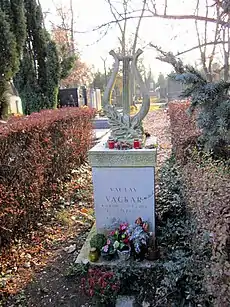Václav Vačkář
Václav Vačkář (12 August 1881 – 4 February 1954) was a Czech composer and conductor of the late romantic era. He is well known for his marches, especially for his march "Šohaj". Vačkář is also a very prolific composer with over 300 original pieces of music.
Václav Vačkář | |
|---|---|
 | |
| Born | 12 August 1881 |
| Died | 4 February 1954 (aged 72) |
| Nationality | Czech |
| Occupation(s) | Composer, conductor |
| Era | Late Romantic |
| Style | Nationalism |
| Spouse | Johanna Faltysová (years of marriage unknown) |
| Children | Dalibor Cyril Vačkář |
| Awards | Smetana Prize of Prague |

Biography
Vačkář received military training in Przemyśl, Poland, from 1895 to 1898 during which he began learning about music through a military program. After his time in Poland Váckář began to play and conduct in various local orchestras including the Czech Philharmonic.[1] In 1952 he wrote the book Instrumentace symfonického orchestru a hudby dechové ("Instrumentation for the Symphony Orchestra and Wind Music") with his aforementioned son Dalibor Cyril Vačkář which is still taught in Czech conservatories.[2]
Influences
Vaćkář's predecessor Bedřich Smetana innovated the Czech nationalistic style. A style that embodied the desire many Czechs felt to secede from the Austrian Empire and was also adopted by many Czech composers — including Vaćkář. Another significant influence on Vačkář was Antonín Dvořák who was also a champion of Czech nationalism. Dvořak composed a series of Bohemian dances called the "Slavonic Dances" which impart inspired Vačkář to compose his own dances from Bohemia.
Family
He was the father of Dalibor Cyril Vačkář, who was also a notable Czech composer.[3]
References
- "Vackár". www.encyclopedia.com. Retrieved 2020-07-12.
- Vačkář, Dalibor C.; Vačkář, Václav (1954). Instrumentace symfonického orchestru a hudby dechové I. Část textová. [II. Notové příklady.] Napsali Václav Vačkář a Dalibor C. Vačkář (in Czech). Státní nakladatelství krásné literatury, hudby a umění.
- Music News from Prague. Music Information Centre, Czech Music Foundation. 1985.